OPER8340: Product Recall Analysis for Ryding-Regency Meat Packers
VerifiedAdded on 2022/09/18
|7
|1462
|34
Report
AI Summary
This report analyzes the product recall of Ryding-Regency Meat Packers Ltd., a Canadian meat processing company. It addresses the risks associated with the foreign purchase of contaminated meat from Wisconsin DOC and proposes risk mitigation strategies, including rigorous supplier pre-qualification and contract incentives. The report outlines the steps taken by Ryding-Regency to conduct the recall, including notifying authorities, making announcements, and advising consumers on product return and compensation. It also explores how the circular economy model can be applied, assessing the company's recall effectiveness, media resource utilization, and potential for product reuse or disposal. Furthermore, the report discusses the importance of fast and efficient transportation, especially the use of cold chain equipment for perishable goods, and emphasizes adherence to relevant regulations for both domestic and international shipments. The analysis incorporates various references to support the findings, offering a comprehensive overview of the product recall and its implications for the company's supply chain and operations.
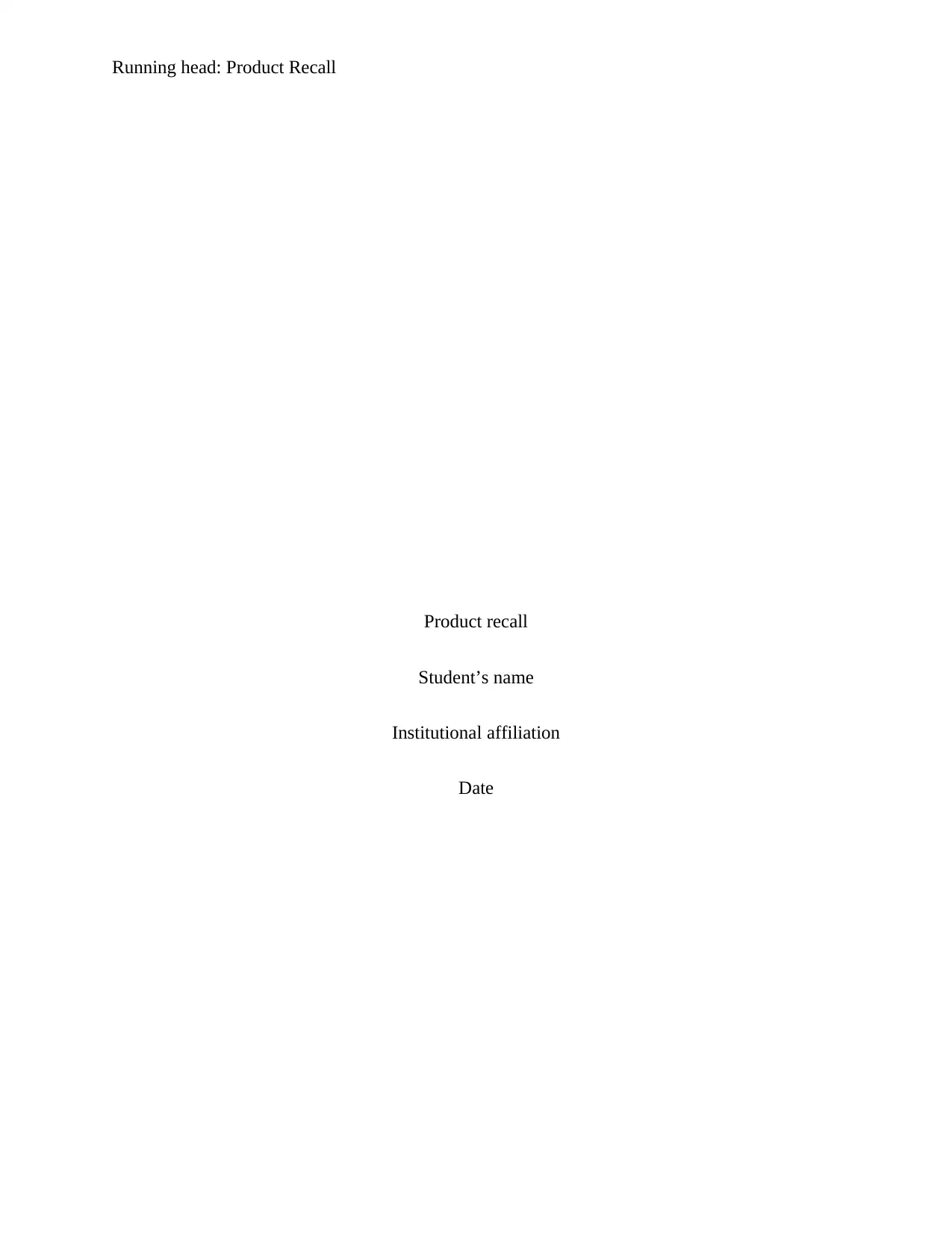
Running head: Product Recall
Product recall
Student’s name
Institutional affiliation
Date
Product recall
Student’s name
Institutional affiliation
Date
Paraphrase This Document
Need a fresh take? Get an instant paraphrase of this document with our AI Paraphraser
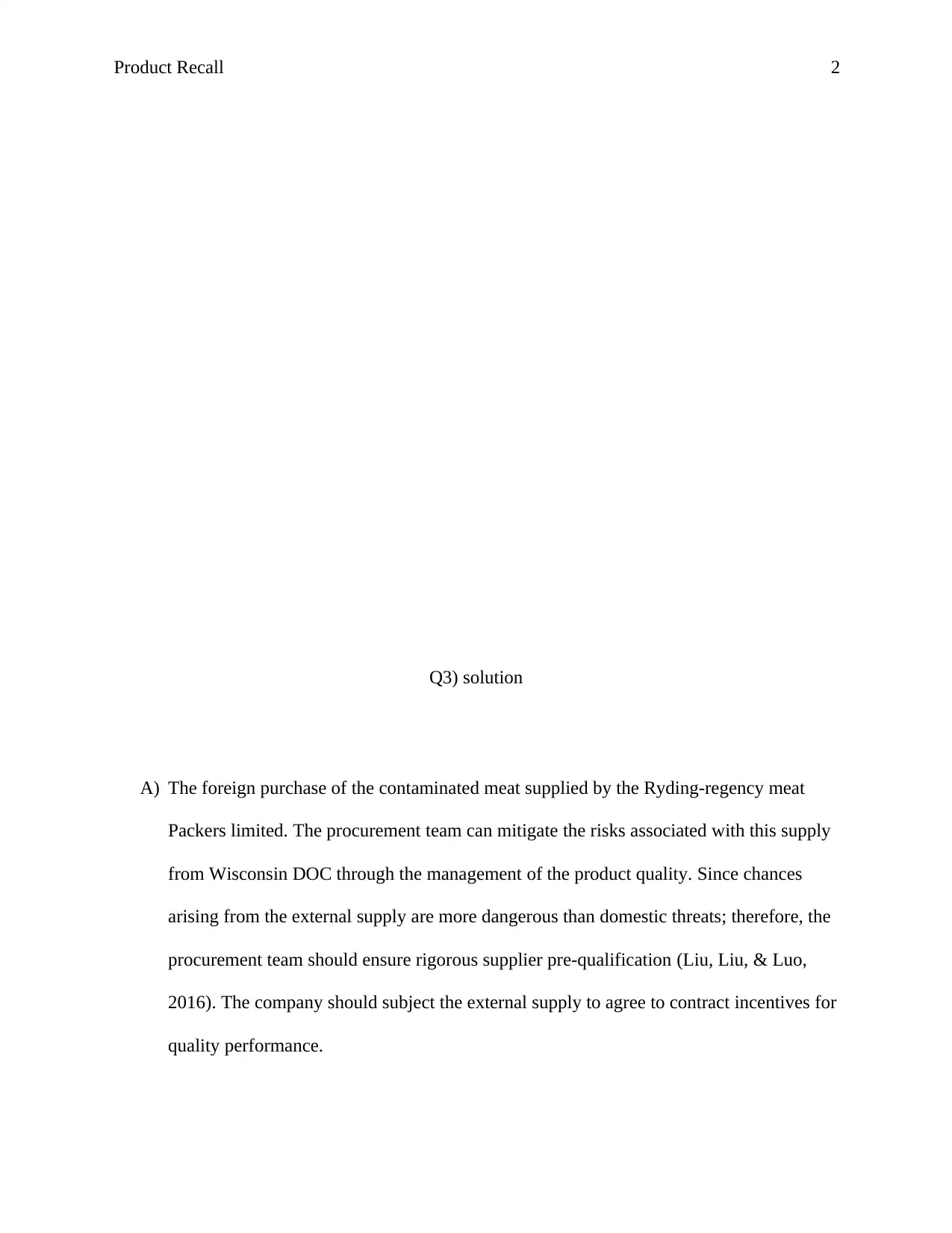
Product Recall 2
Q3) solution
A) The foreign purchase of the contaminated meat supplied by the Ryding-regency meat
Packers limited. The procurement team can mitigate the risks associated with this supply
from Wisconsin DOC through the management of the product quality. Since chances
arising from the external supply are more dangerous than domestic threats; therefore, the
procurement team should ensure rigorous supplier pre-qualification (Liu, Liu, & Luo,
2016). The company should subject the external supply to agree to contract incentives for
quality performance.
Q3) solution
A) The foreign purchase of the contaminated meat supplied by the Ryding-regency meat
Packers limited. The procurement team can mitigate the risks associated with this supply
from Wisconsin DOC through the management of the product quality. Since chances
arising from the external supply are more dangerous than domestic threats; therefore, the
procurement team should ensure rigorous supplier pre-qualification (Liu, Liu, & Luo,
2016). The company should subject the external supply to agree to contract incentives for
quality performance.
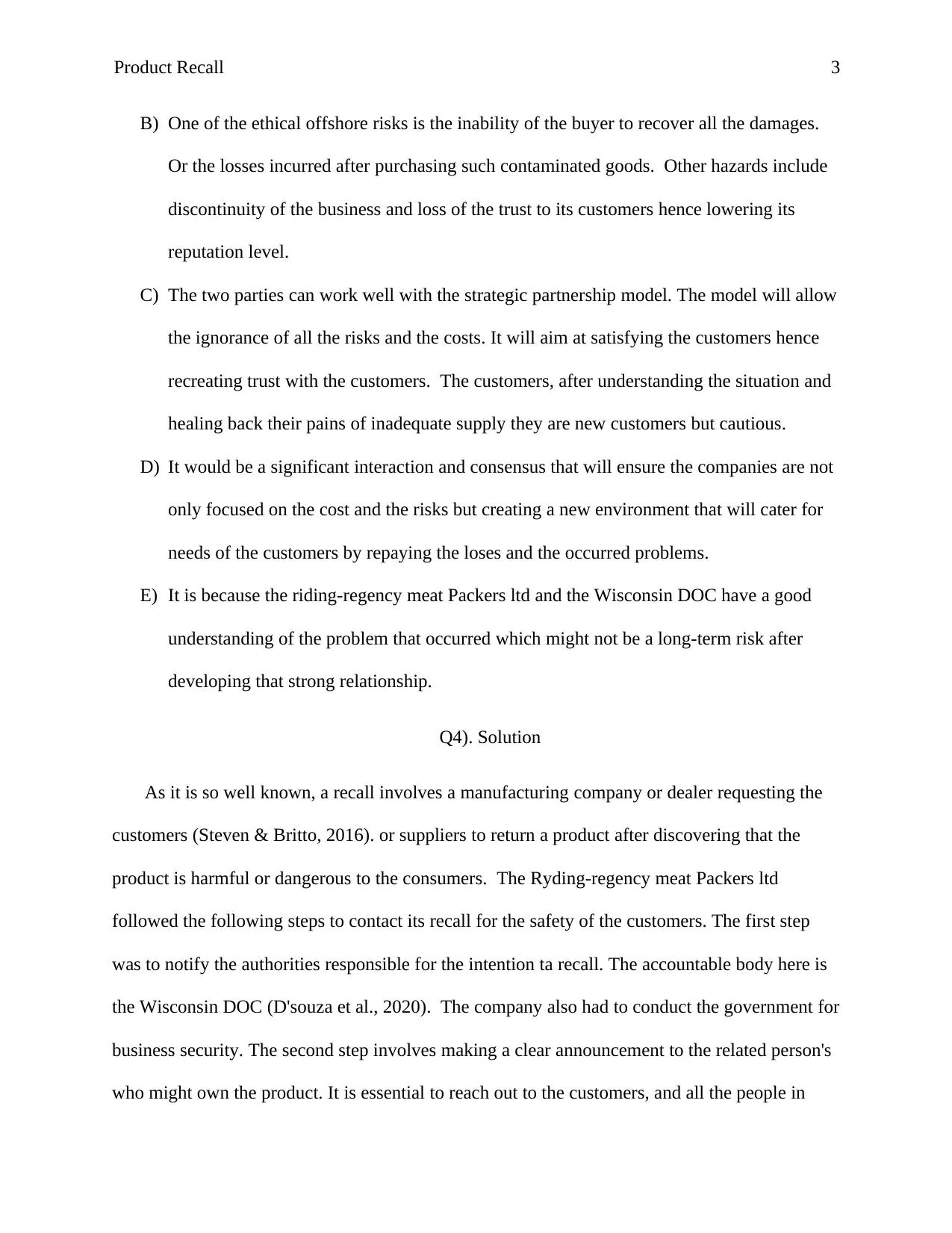
Product Recall 3
B) One of the ethical offshore risks is the inability of the buyer to recover all the damages.
Or the losses incurred after purchasing such contaminated goods. Other hazards include
discontinuity of the business and loss of the trust to its customers hence lowering its
reputation level.
C) The two parties can work well with the strategic partnership model. The model will allow
the ignorance of all the risks and the costs. It will aim at satisfying the customers hence
recreating trust with the customers. The customers, after understanding the situation and
healing back their pains of inadequate supply they are new customers but cautious.
D) It would be a significant interaction and consensus that will ensure the companies are not
only focused on the cost and the risks but creating a new environment that will cater for
needs of the customers by repaying the loses and the occurred problems.
E) It is because the riding-regency meat Packers ltd and the Wisconsin DOC have a good
understanding of the problem that occurred which might not be a long-term risk after
developing that strong relationship.
Q4). Solution
As it is so well known, a recall involves a manufacturing company or dealer requesting the
customers (Steven & Britto, 2016). or suppliers to return a product after discovering that the
product is harmful or dangerous to the consumers. The Ryding-regency meat Packers ltd
followed the following steps to contact its recall for the safety of the customers. The first step
was to notify the authorities responsible for the intention ta recall. The accountable body here is
the Wisconsin DOC (D'souza et al., 2020). The company also had to conduct the government for
business security. The second step involves making a clear announcement to the related person's
who might own the product. It is essential to reach out to the customers, and all the people in
B) One of the ethical offshore risks is the inability of the buyer to recover all the damages.
Or the losses incurred after purchasing such contaminated goods. Other hazards include
discontinuity of the business and loss of the trust to its customers hence lowering its
reputation level.
C) The two parties can work well with the strategic partnership model. The model will allow
the ignorance of all the risks and the costs. It will aim at satisfying the customers hence
recreating trust with the customers. The customers, after understanding the situation and
healing back their pains of inadequate supply they are new customers but cautious.
D) It would be a significant interaction and consensus that will ensure the companies are not
only focused on the cost and the risks but creating a new environment that will cater for
needs of the customers by repaying the loses and the occurred problems.
E) It is because the riding-regency meat Packers ltd and the Wisconsin DOC have a good
understanding of the problem that occurred which might not be a long-term risk after
developing that strong relationship.
Q4). Solution
As it is so well known, a recall involves a manufacturing company or dealer requesting the
customers (Steven & Britto, 2016). or suppliers to return a product after discovering that the
product is harmful or dangerous to the consumers. The Ryding-regency meat Packers ltd
followed the following steps to contact its recall for the safety of the customers. The first step
was to notify the authorities responsible for the intention ta recall. The accountable body here is
the Wisconsin DOC (D'souza et al., 2020). The company also had to conduct the government for
business security. The second step involves making a clear announcement to the related person's
who might own the product. It is essential to reach out to the customers, and all the people in
⊘ This is a preview!⊘
Do you want full access?
Subscribe today to unlock all pages.

Trusted by 1+ million students worldwide
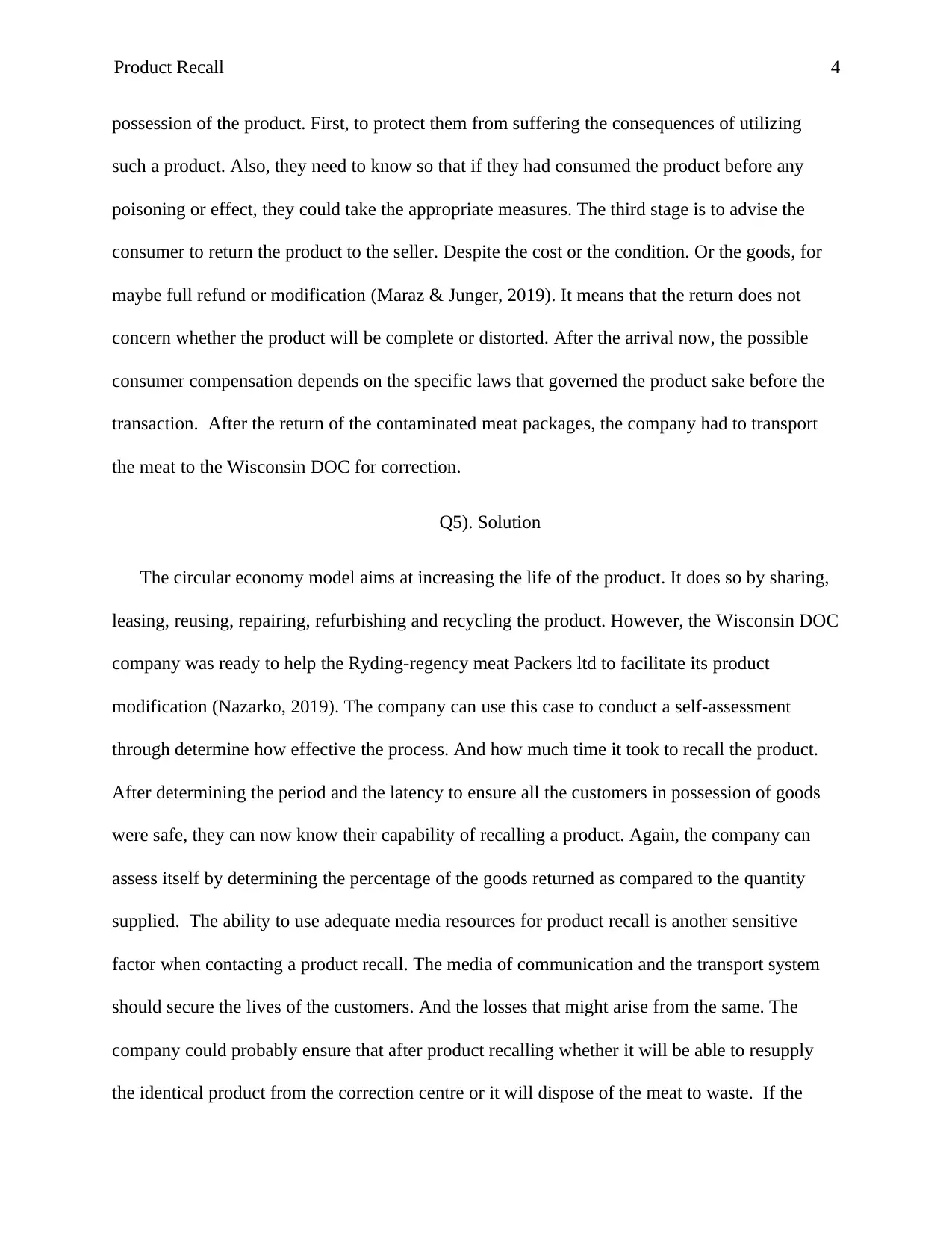
Product Recall 4
possession of the product. First, to protect them from suffering the consequences of utilizing
such a product. Also, they need to know so that if they had consumed the product before any
poisoning or effect, they could take the appropriate measures. The third stage is to advise the
consumer to return the product to the seller. Despite the cost or the condition. Or the goods, for
maybe full refund or modification (Maraz & Junger, 2019). It means that the return does not
concern whether the product will be complete or distorted. After the arrival now, the possible
consumer compensation depends on the specific laws that governed the product sake before the
transaction. After the return of the contaminated meat packages, the company had to transport
the meat to the Wisconsin DOC for correction.
Q5). Solution
The circular economy model aims at increasing the life of the product. It does so by sharing,
leasing, reusing, repairing, refurbishing and recycling the product. However, the Wisconsin DOC
company was ready to help the Ryding-regency meat Packers ltd to facilitate its product
modification (Nazarko, 2019). The company can use this case to conduct a self-assessment
through determine how effective the process. And how much time it took to recall the product.
After determining the period and the latency to ensure all the customers in possession of goods
were safe, they can now know their capability of recalling a product. Again, the company can
assess itself by determining the percentage of the goods returned as compared to the quantity
supplied. The ability to use adequate media resources for product recall is another sensitive
factor when contacting a product recall. The media of communication and the transport system
should secure the lives of the customers. And the losses that might arise from the same. The
company could probably ensure that after product recalling whether it will be able to resupply
the identical product from the correction centre or it will dispose of the meat to waste. If the
possession of the product. First, to protect them from suffering the consequences of utilizing
such a product. Also, they need to know so that if they had consumed the product before any
poisoning or effect, they could take the appropriate measures. The third stage is to advise the
consumer to return the product to the seller. Despite the cost or the condition. Or the goods, for
maybe full refund or modification (Maraz & Junger, 2019). It means that the return does not
concern whether the product will be complete or distorted. After the arrival now, the possible
consumer compensation depends on the specific laws that governed the product sake before the
transaction. After the return of the contaminated meat packages, the company had to transport
the meat to the Wisconsin DOC for correction.
Q5). Solution
The circular economy model aims at increasing the life of the product. It does so by sharing,
leasing, reusing, repairing, refurbishing and recycling the product. However, the Wisconsin DOC
company was ready to help the Ryding-regency meat Packers ltd to facilitate its product
modification (Nazarko, 2019). The company can use this case to conduct a self-assessment
through determine how effective the process. And how much time it took to recall the product.
After determining the period and the latency to ensure all the customers in possession of goods
were safe, they can now know their capability of recalling a product. Again, the company can
assess itself by determining the percentage of the goods returned as compared to the quantity
supplied. The ability to use adequate media resources for product recall is another sensitive
factor when contacting a product recall. The media of communication and the transport system
should secure the lives of the customers. And the losses that might arise from the same. The
company could probably ensure that after product recalling whether it will be able to resupply
the identical product from the correction centre or it will dispose of the meat to waste. If the
Paraphrase This Document
Need a fresh take? Get an instant paraphrase of this document with our AI Paraphraser
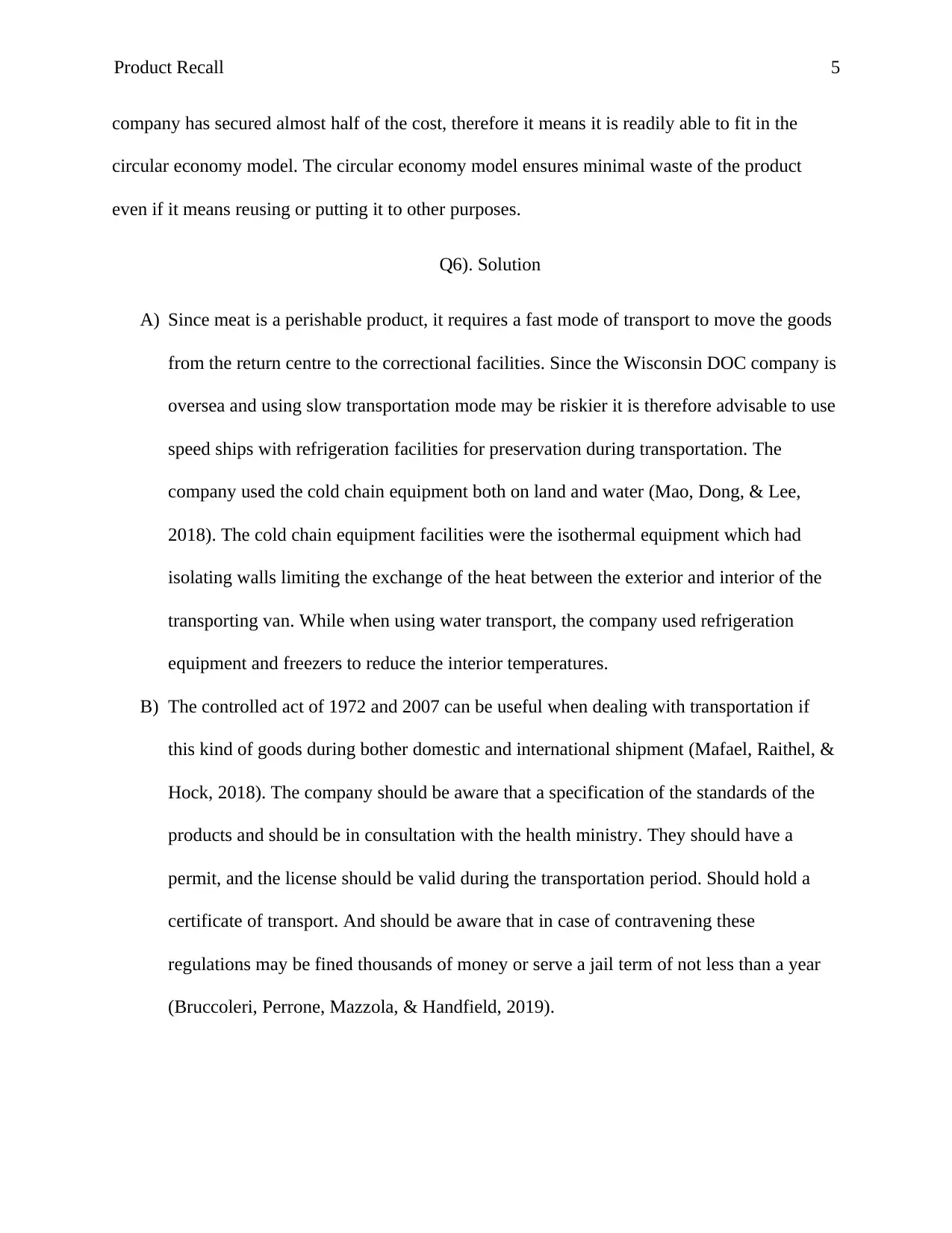
Product Recall 5
company has secured almost half of the cost, therefore it means it is readily able to fit in the
circular economy model. The circular economy model ensures minimal waste of the product
even if it means reusing or putting it to other purposes.
Q6). Solution
A) Since meat is a perishable product, it requires a fast mode of transport to move the goods
from the return centre to the correctional facilities. Since the Wisconsin DOC company is
oversea and using slow transportation mode may be riskier it is therefore advisable to use
speed ships with refrigeration facilities for preservation during transportation. The
company used the cold chain equipment both on land and water (Mao, Dong, & Lee,
2018). The cold chain equipment facilities were the isothermal equipment which had
isolating walls limiting the exchange of the heat between the exterior and interior of the
transporting van. While when using water transport, the company used refrigeration
equipment and freezers to reduce the interior temperatures.
B) The controlled act of 1972 and 2007 can be useful when dealing with transportation if
this kind of goods during bother domestic and international shipment (Mafael, Raithel, &
Hock, 2018). The company should be aware that a specification of the standards of the
products and should be in consultation with the health ministry. They should have a
permit, and the license should be valid during the transportation period. Should hold a
certificate of transport. And should be aware that in case of contravening these
regulations may be fined thousands of money or serve a jail term of not less than a year
(Bruccoleri, Perrone, Mazzola, & Handfield, 2019).
company has secured almost half of the cost, therefore it means it is readily able to fit in the
circular economy model. The circular economy model ensures minimal waste of the product
even if it means reusing or putting it to other purposes.
Q6). Solution
A) Since meat is a perishable product, it requires a fast mode of transport to move the goods
from the return centre to the correctional facilities. Since the Wisconsin DOC company is
oversea and using slow transportation mode may be riskier it is therefore advisable to use
speed ships with refrigeration facilities for preservation during transportation. The
company used the cold chain equipment both on land and water (Mao, Dong, & Lee,
2018). The cold chain equipment facilities were the isothermal equipment which had
isolating walls limiting the exchange of the heat between the exterior and interior of the
transporting van. While when using water transport, the company used refrigeration
equipment and freezers to reduce the interior temperatures.
B) The controlled act of 1972 and 2007 can be useful when dealing with transportation if
this kind of goods during bother domestic and international shipment (Mafael, Raithel, &
Hock, 2018). The company should be aware that a specification of the standards of the
products and should be in consultation with the health ministry. They should have a
permit, and the license should be valid during the transportation period. Should hold a
certificate of transport. And should be aware that in case of contravening these
regulations may be fined thousands of money or serve a jail term of not less than a year
(Bruccoleri, Perrone, Mazzola, & Handfield, 2019).
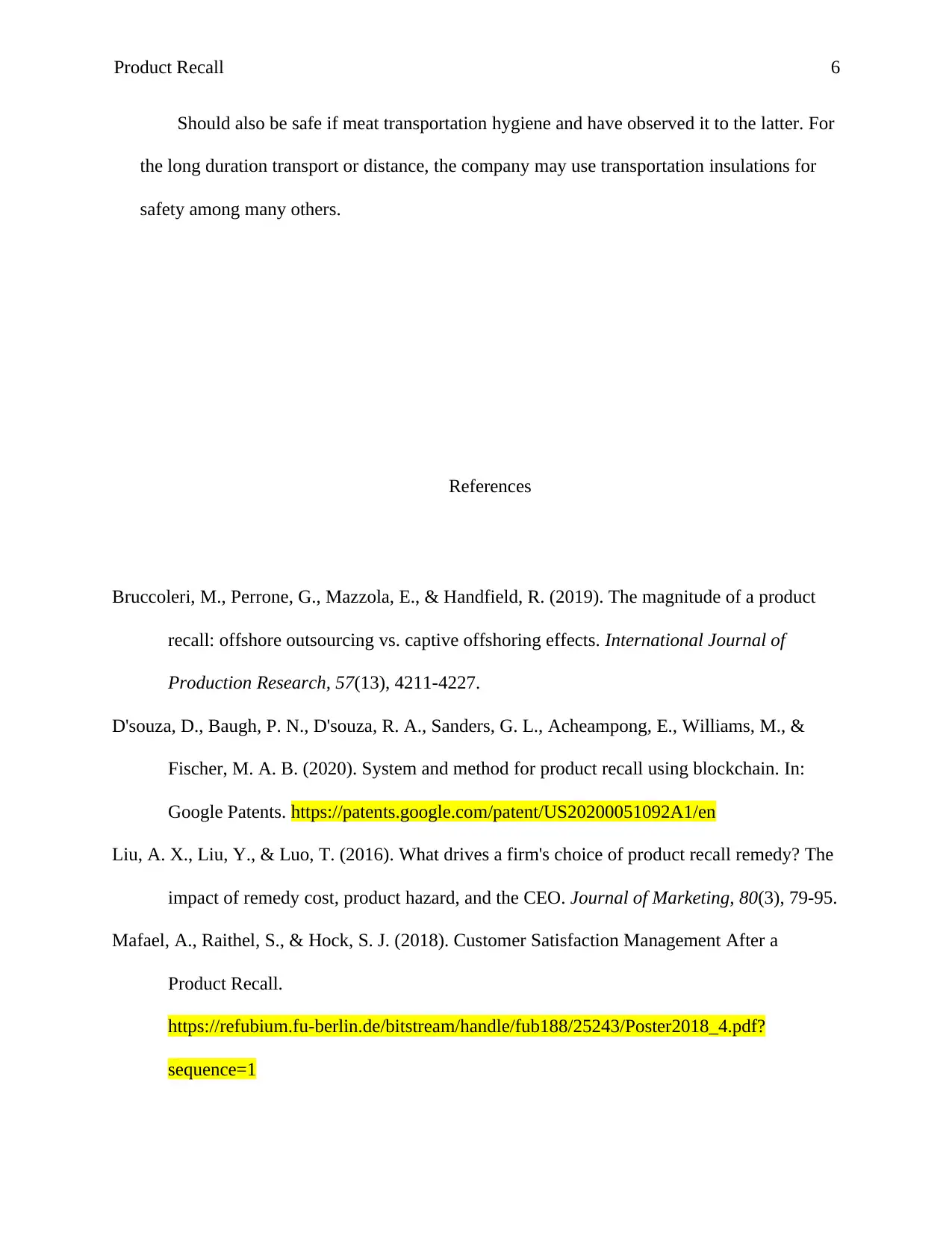
Product Recall 6
Should also be safe if meat transportation hygiene and have observed it to the latter. For
the long duration transport or distance, the company may use transportation insulations for
safety among many others.
References
Bruccoleri, M., Perrone, G., Mazzola, E., & Handfield, R. (2019). The magnitude of a product
recall: offshore outsourcing vs. captive offshoring effects. International Journal of
Production Research, 57(13), 4211-4227.
D'souza, D., Baugh, P. N., D'souza, R. A., Sanders, G. L., Acheampong, E., Williams, M., &
Fischer, M. A. B. (2020). System and method for product recall using blockchain. In:
Google Patents. https://patents.google.com/patent/US20200051092A1/en
Liu, A. X., Liu, Y., & Luo, T. (2016). What drives a firm's choice of product recall remedy? The
impact of remedy cost, product hazard, and the CEO. Journal of Marketing, 80(3), 79-95.
Mafael, A., Raithel, S., & Hock, S. J. (2018). Customer Satisfaction Management After a
Product Recall.
https://refubium.fu-berlin.de/bitstream/handle/fub188/25243/Poster2018_4.pdf?
sequence=1
Should also be safe if meat transportation hygiene and have observed it to the latter. For
the long duration transport or distance, the company may use transportation insulations for
safety among many others.
References
Bruccoleri, M., Perrone, G., Mazzola, E., & Handfield, R. (2019). The magnitude of a product
recall: offshore outsourcing vs. captive offshoring effects. International Journal of
Production Research, 57(13), 4211-4227.
D'souza, D., Baugh, P. N., D'souza, R. A., Sanders, G. L., Acheampong, E., Williams, M., &
Fischer, M. A. B. (2020). System and method for product recall using blockchain. In:
Google Patents. https://patents.google.com/patent/US20200051092A1/en
Liu, A. X., Liu, Y., & Luo, T. (2016). What drives a firm's choice of product recall remedy? The
impact of remedy cost, product hazard, and the CEO. Journal of Marketing, 80(3), 79-95.
Mafael, A., Raithel, S., & Hock, S. J. (2018). Customer Satisfaction Management After a
Product Recall.
https://refubium.fu-berlin.de/bitstream/handle/fub188/25243/Poster2018_4.pdf?
sequence=1
⊘ This is a preview!⊘
Do you want full access?
Subscribe today to unlock all pages.

Trusted by 1+ million students worldwide
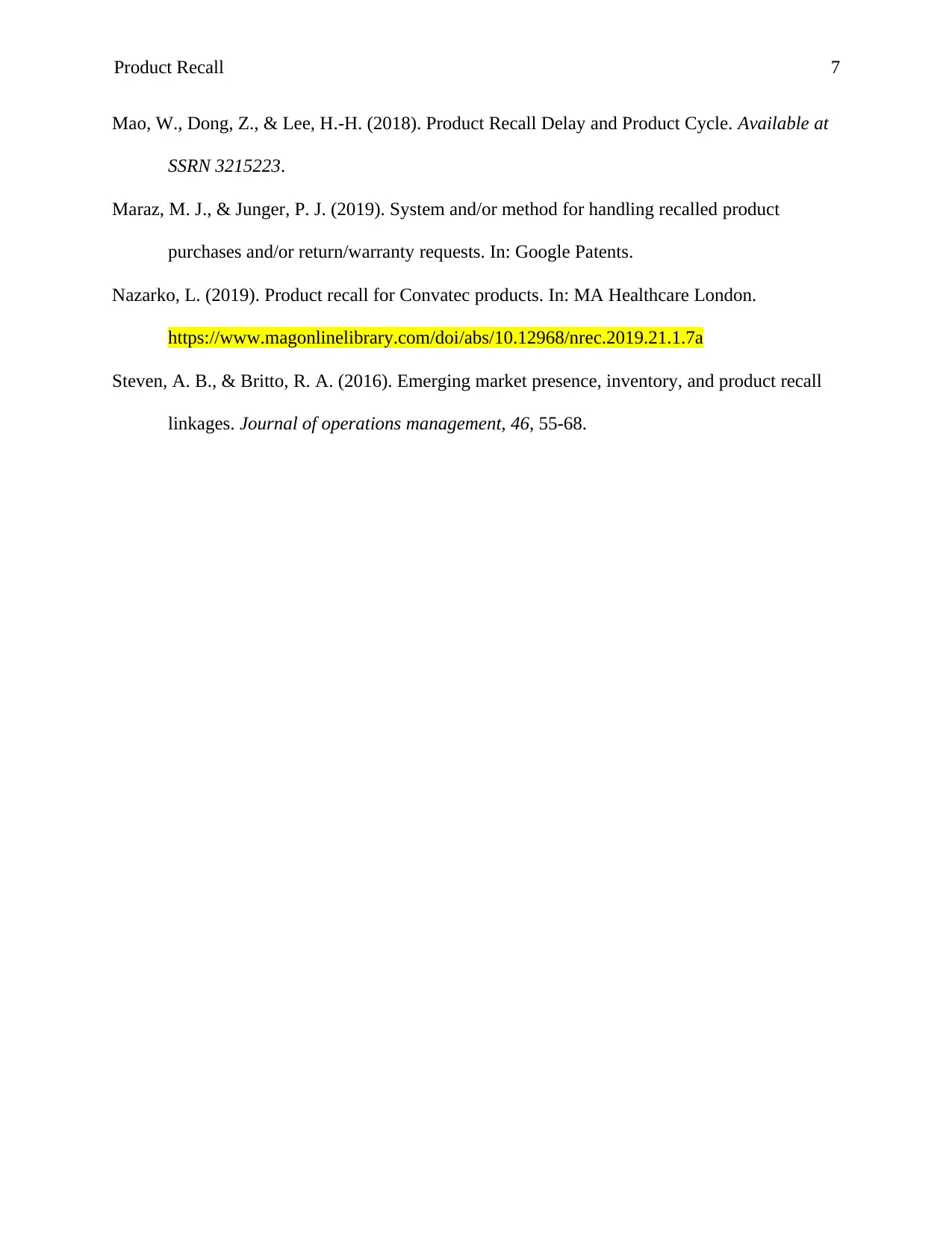
Product Recall 7
Mao, W., Dong, Z., & Lee, H.-H. (2018). Product Recall Delay and Product Cycle. Available at
SSRN 3215223.
Maraz, M. J., & Junger, P. J. (2019). System and/or method for handling recalled product
purchases and/or return/warranty requests. In: Google Patents.
Nazarko, L. (2019). Product recall for Convatec products. In: MA Healthcare London.
https://www.magonlinelibrary.com/doi/abs/10.12968/nrec.2019.21.1.7a
Steven, A. B., & Britto, R. A. (2016). Emerging market presence, inventory, and product recall
linkages. Journal of operations management, 46, 55-68.
Mao, W., Dong, Z., & Lee, H.-H. (2018). Product Recall Delay and Product Cycle. Available at
SSRN 3215223.
Maraz, M. J., & Junger, P. J. (2019). System and/or method for handling recalled product
purchases and/or return/warranty requests. In: Google Patents.
Nazarko, L. (2019). Product recall for Convatec products. In: MA Healthcare London.
https://www.magonlinelibrary.com/doi/abs/10.12968/nrec.2019.21.1.7a
Steven, A. B., & Britto, R. A. (2016). Emerging market presence, inventory, and product recall
linkages. Journal of operations management, 46, 55-68.
1 out of 7
Your All-in-One AI-Powered Toolkit for Academic Success.
+13062052269
info@desklib.com
Available 24*7 on WhatsApp / Email
![[object Object]](/_next/static/media/star-bottom.7253800d.svg)
Unlock your academic potential
Copyright © 2020–2025 A2Z Services. All Rights Reserved. Developed and managed by ZUCOL.


